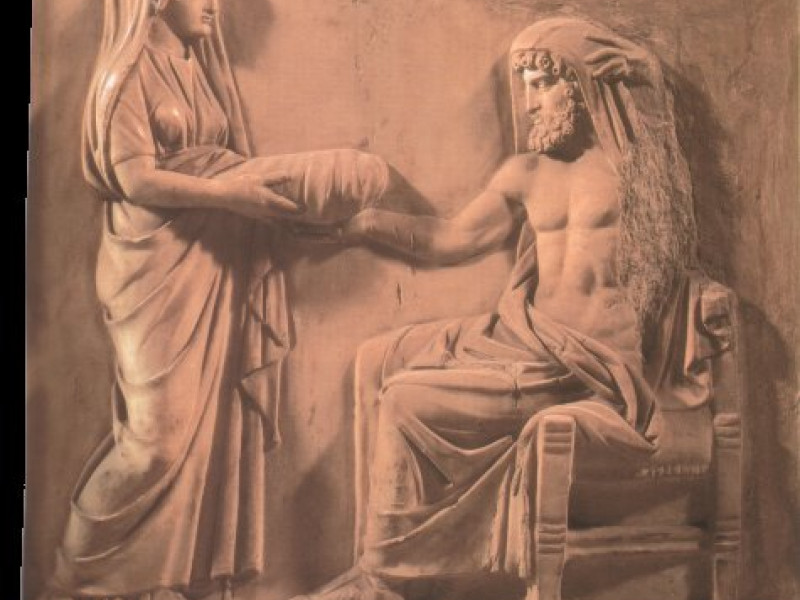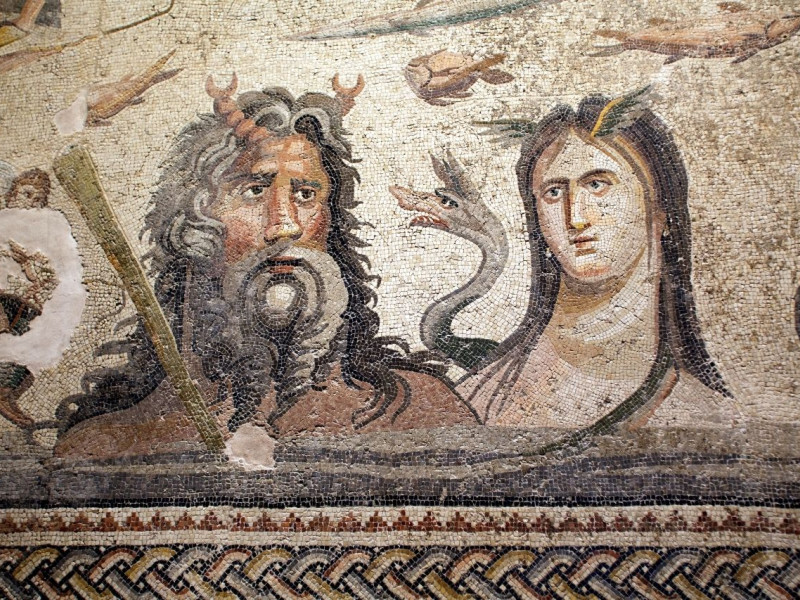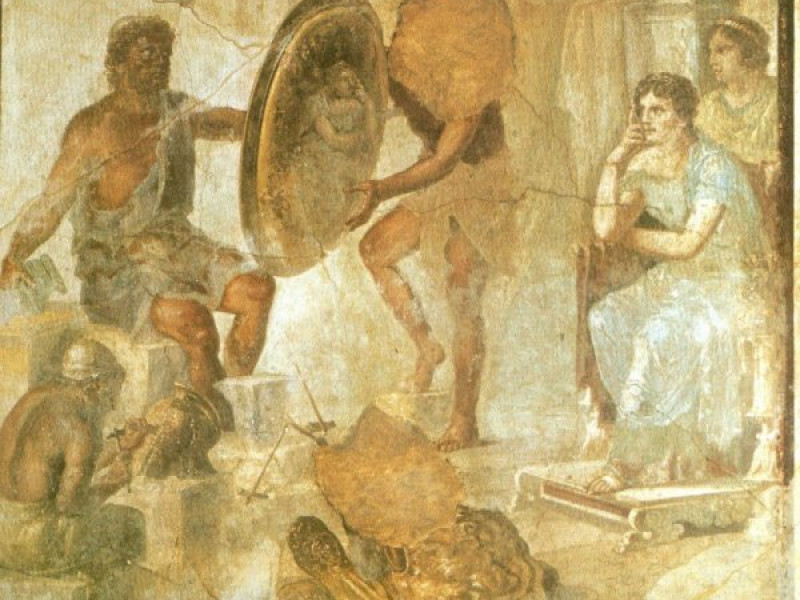Atlas
Atlas: Titan of Strength and Endurance
Atlas, Titan of strength, played a unique role in Greek mythology, but there is a popular misconception about his lore. Often, it is believed that Atlas bore the weight of the world. However, it is actually the sky that he supported with his massive shoulders.
In pre-Renaissance art, the sky was often presented as a “celestial sphere,” a giant orb etched with symbols of the constellations. This depiction was often mistaken as a globe of the earth. In time, the idea of Atlas carrying the world became the more accepted version of his image, even though it has nothing to do with the original myth. The Twentieth century Novel Atlas Shrugged perpetuated this misunderstanding as well.
Psychologically, the mythical Atlas lends his likeness to the condition called “Atlas personality” or “Atlas complex.” These terms describe people burdened with an unusual amount of responsibility at a premature age. As adults, such persons may feel obsessed with taking on unnecessary burdens, caregiving, and guarding the feelings of others, often ignoring their own well-being.
When people think of Atlas, they seldom go beyond the artistic and psychological connections. However, the story behind why Atlas bore his burden is one of the most important in Greek Mythology.
Atlas’ Origins: His Birth and Family Life
Atlas was one of the 12 Titans, a race of giants that ruled the world before the Olympian gods. His father was Iapetus, brother of Cronos, and his mother was an ocean nymph, either Clymene or Asia, depending on the source. He was the brother of Prometheus, Epimetheus, and Menoetius, who also had important roles in Greek myth. He had one sister, Ankihale.
Although the wives of Atlas were seldom mentioned, the names of Atlas’s daughters are easily recognized. With Pleione, he sired his most famous daughters, the seven Pleiades, one of which was the mother of Hermes. They were also the parents of the nymph Calypso, who figured prominently in the Odyssey of Homer. The Hyades and the Hesperides were also his daughters by other wives.
Atlas’ Symbols and Attributes
Atlas’s best-known symbol was the celestial sphere; it is also said that he carried a spear. One may wonder how he could wield a spear while holding the sky in place. Some sources suggested that he had four arms, so perhaps he could spare one when needed.
The Greeks considered Atlas the most powerful Titan, even before he took the weight of the sky onto his shoulders. Because of his never-ending task, Atlas was also associated with pain and suffering but more with endurance. In some areas, he was called Atlas Telamon, “the enduring Atlas.” Less considered are his traits of impetuosity and gullibility, but these traits figured heavily in his stories.
Besides being a symbol of strength and endurance, the Greek Titan Atlas was also associated with other disciplines. Since he supported the sky, it seems evident that he became the Titan god of astronomy and the heavens. He was also an expert in mathematics and philosophy.
Atlas gave his name to several geographic features, including the Atlantic Ocean, the Atlas Mountains in Northwest Africa, and, according to Pluto, the mysterious island of Atlantis. He became connected with cartography in the 16th century when Gerardus Mercator dedicated his book of maps to the Titan. After that time, such books were known as atlases.
Atlas in Greek Mythology: The Titanomachy and Atlas’ Punishment
The Titanomachy, or War of the Titans, was a pivotal moment in Greek mythology. The 10-year battle marked the end of the reign of the Titans and the dawn of the Olympian gods. The conflict was rooted in family power struggles that reached back to the beginning of creation.
The first primordial god was Uranus (Ouranos), who sired the first 12 Titans and other races. Cronos overthrew his father and assumed his throne. Afraid that his own children would do the same to him, he ate them. His son Zeus escaped this fate and was hidden in Crete. He returned as an adult and tricked Cronos into vomiting up his children, who emerged full grown.
Battle lines were drawn. Some of the Titans, like Prometheus, Epimetheus, and Themis, sided with Zeus. Due to his great strength, Atlas led the Titans in their fight. His headstrong nature made him a formidable opponent, but it also made him a notable enemy of Zeus.
With the sides evenly matched, the battle lasted 10 years, and the world suffered. At last, Zeus went to Tartarus and released the Cyclopes and the Hecatonchires, children of Uranus. The Cyclopes crafted powerful weapons for Zeus and his brothers, and the hundred-handed Hecatonchires hurled mountains and boulders at the Titan army. Soon, the Olympians secured their victory.
As punishment, Zeus imprisoned the Titans in Tartarus, with a few exceptions. Those that fought on the side of the Olympians were spared. For leading the Titan army and insulting Zeus, Atlas was given the task of supporting the sky on his shoulders, keeping it from falling and crushing the earth and all its inhabitants.
It has been wondered why Atlas accepted his punishment, why he didn’t just walk away and let the sky fall. Some speculate that he did it to keep the sky from crushing his daughters, or more nobly, all of humanity. Or, perhaps he was merely too stubborn to give up. Others suggest that, due to his gullible nature, he simply did not consider it an option.
Atlas and Heracles: The Demigod and the Gullible Titan
Since Atlas’s task required him to remain in one location, few myths after the Titanomachy involved Atlas. In the best known of these tales, he tried to trick Heracles (Hercules) but was tricked in return.
In one of the famous 12 Labors of Heracles, King Eurystheus required Hercules to steal three golden apples from Hera’s garden in the west. The garden was guarded by Atlas’s daughters, the Hesperides, and the hundred-headed dragon Ladon. Heracles figured that Atlas might have an easier time getting the apples from his daughters than he would.
Atlas was willing, but he could not leave his post, or the sky would crush the earth. He convinced Heracles to trade places temporarily; Heracles held up the sky while Atlas retrieved the apples. The strength of Heracles was almost as famous as that of Atlas, and he was the only one who could have relieved the Titan’s burden. Some sources do recount that Athena assisted Heracles.
Atlas retrieved the apples but was understandably reluctant to resume his place. He told Heracles he would take the apples to King Eurystheus himself and leave Heracles to support the sky. Slyly, Heracles agreed, only asking that Atlas take his place for a second while he folded up his cloak as a pad for his shoulders. Foolishly, Atlas agreed. When Atlas’s shoulders once again bore the weight of the celestial sphere, Heracles picked up the apples and escaped.
In one version of the story, Heracles showed mercy on Atlas by creating two immense pillars to relieve Atlas of his punishment. Heracles also freed Atlas’s brother, Prometheus, from another punishment decreed by Zeus. It seemed that Heracles made a habit of liberating his father’s prisoners.
Atlas and Perseus: The Demise of Atlas
The only other Greek hero to visit Atlas was Perseus, and he brought an end to Atlas’s story. Perseus was the son of Zeus, who defeated the gorgon Medusa and saved Andromeda from the sea monster Cetus.
Perseus asked Atlas for hospitality and safe passage as he was passing through Atlas’s land. Atlas was wary of being tricked again, and his hot-headed nature flared. He rudely refused to give Perseus hospitality, which was a grave insult. In retaliation, Perseus reached into his satchel and pulled out Medusa’s head, showing it to Atlas and turning him to stone. This myth was said to be the origin of the Atlas Mountains in present-day Morocco.
Some sources added elements to this story that are inconsistent with the general mythology of Atlas. Instead of his role as a sky-bearer, he is portrayed as a shepherd by the poet Polyidus and a king by Ovid.
Conclusion
Though his whole story is often unknown or misunderstood, the image of Atlas supporting the sky is one of the more recognizable images in Greek Mythology. Let’s recap what we have learned.
Atlas was the most powerful Titan in Greek mythology but perhaps the most gullible.
Zeus condemned him forever to carry the weight of the sky on his shoulders.
Post-classical art and literature have popularized the misconception that he carries the world on his shoulders rather than the heavens.
He was the patron of astronomy and cartography.
He was tricked by Heracles and turned to stone by Perseus.
He lent his name to an ocean, a mountain range, a mythical island, and a book of maps.
The tales associated with Atlas remind us that great strength doesn’t guarantee victory, and a bad attitude can often cause trouble. However, Atlas will forever be admired for his endurance and perseverance at a task that no one else could have accomplished.











